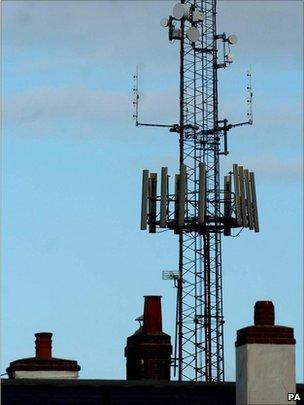Money for masts
- Published
- comments

As our 3G survey showed back in August, mobile phone coverage in the UK still leaves quite a lot to be desired. This morning the chancellor promised government action to improve matters.
George Osborne told the Conservative Party conference that up to £150m would be spent to improve mobile coverage, helping up to six million people to get a better signal - or to get connected at all. The aim will be to extend coverage to 99% of the country.
So where will the money be spent? On procuring phone mast sites, apparently, and Ofcom is being given the task of sorting that out. The regulator has welcomed the initiative, and the fact that public funds are being made available - though it stresses that the government will keep hold of the cash and decide how it is handed out. Here's the Ofcom statement:
"We have maintained for some time that market forces alone will not solve these problems. In particular, poor and unreliable coverage, which exists mostly in rural areas, is likely to persist to some degree as there is limited scope for commercially-driven improvements. "
Ofcom confirms that this is the first time public money has been spent nationwide to boost mobile phone coverage. And it all begs several questions. Who will get the money? Who will decide where a new mast is needed? How many masts will be needed? The regulator and the government says the details still have to be worked out.
But this could be very good news for one sector of the mobile industry. Femtocells - essentially mini phone masts that boost coverage in your home - have been the "next big thing" in mobile for some years, without ever really taking off.
Now Picochip, a company which makes them, is claiming they could be the answer both to patchy rural coverage and to the next generation of mobile networks. The firm has just issued a report, external claiming that 70,000 new cells will be needed to bring 4G broadband to London.
Looking at that, I assumed it meant 70,000 new masts cluttering up the London skyline - and a big headache to get planning permission. But Picochip executives were quick to reassure me that what they were talking about was the kind of box that could be attached to the side of a building or concealed in street furniture. And the firm reckons this could also be a relatively cheap way of taking a broadband signal and beaming it across a village with poor or non-existent mobile coverage.
A warm welcome too for Mr Osborne's idea from Vodafone, which says it has pioneered the commercial use of femtocell technology and is already trialling it in rural locations. "We look forward to talking with the government," the firm says, "about how we can play our part in ensuring everyone gets mobile phone coverage."
But there are still a couple more questions that need to be answered. Why should public money be handed over to a mobile phone industry that is making some very respectable profits? And if Ofcom has been doing its job why, according to its own Consumer Panel, are there almost as many notspots now as there were 10 years ago?